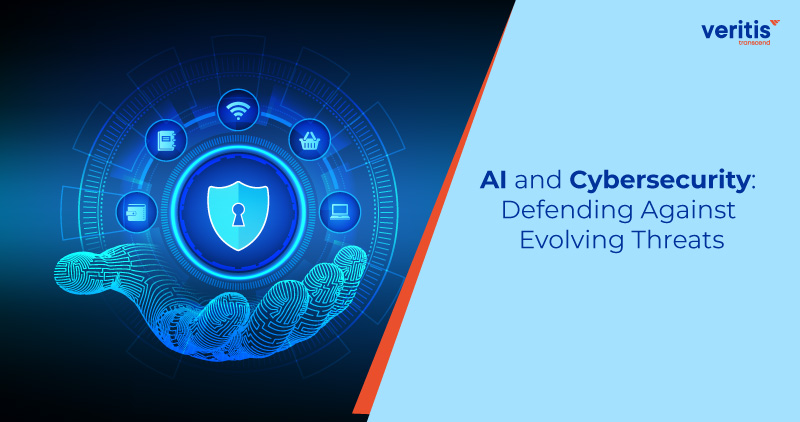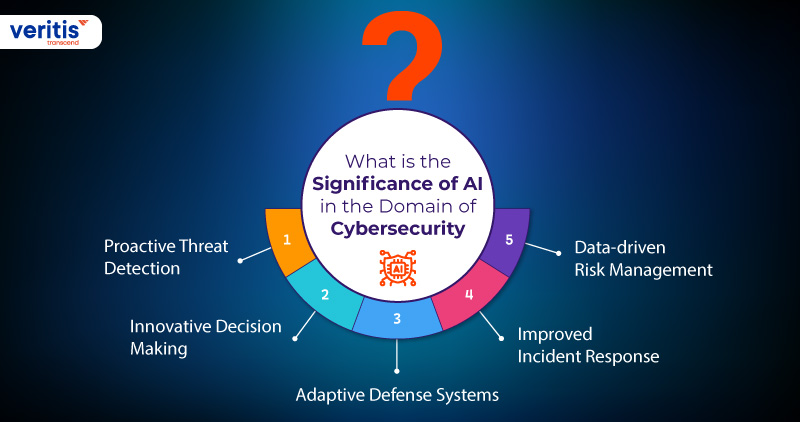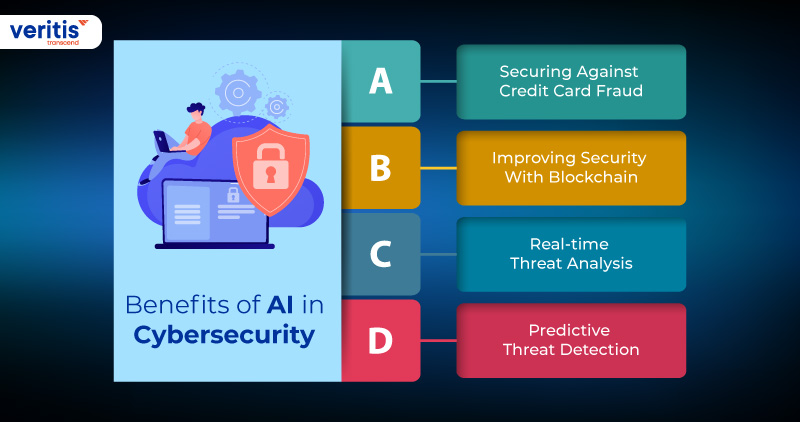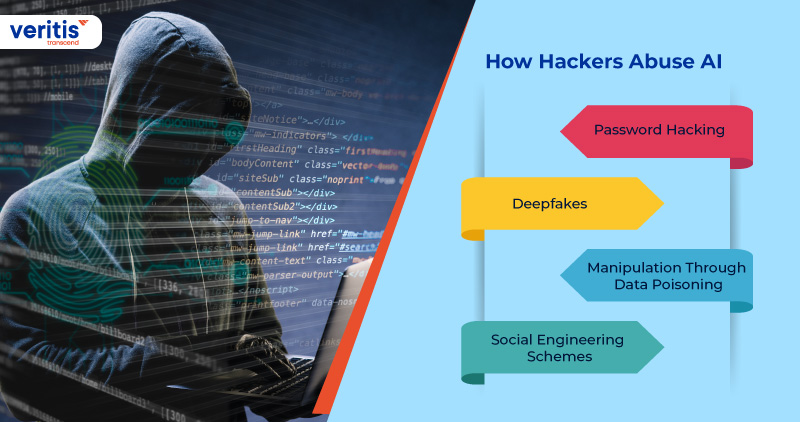
Artificial Intelligence (AI) has evolved as a game-changer in the ever-shifting digital security landscape, introducing advanced techniques to combat the evolving threat landscape. Integrating AI into cybersecurity is not merely a trend but a strategic imperative for countless organizations, revolutionizing defense mechanisms against cyber threats.
According to a groundbreaking report by MarketsandMarkets, the global AI in cybersecurity market is set to skyrocket from USD 8.8 billion in 2020 to an astonishing USD 38.2 billion by 2026, with a CAGR of 23.3%. This surge is propelled by the urgent need to counteract the rising tide of cyber threats amid a shortage of skilled cybersecurity professionals.
In this dynamic field of digital fortification, the collaboration between AI and cybersecurity stands as a formidable force. As the virtual battleground expands and adversaries grow more sophisticated, AI and cybersecurity become beacons of innovation and resilience. The statistics underscore this narrative of evolution, revealing a forecast that the global AI market is on track to reach a monumental USD 1.5 trillion by 2025 (Source: Statista). The investment landscape mirrors this momentum, with over 25% of funding to US-based startups in 2023 flowing into AI companies (Source: Crunchbase).
Internally, AI is already making waves, integrated into operations by 65% of companies, while an additional 74% are actively testing its potential applications (Source: Deloitte). This disruptive force extends across sectors, promising widespread innovation in healthcare, finance, manufacturing, and retail (Source: McKinsey & Company). The World Economic Forum predicts a job creation wave, potentially yielding millions of new opportunities, underlining the transformative impact of AI.
Shifting the focus to cybersecurity, the urgency for robust defenses is highlighted by a projected USD 300 billion global cybersecurity market by 2027 (Source: Gartner). The rising cost of data breaches, averaging USD 4.35 million per incident (Source: IBM), emphasizes the need for innovative AI cybersecurity solutions.
Enter AI, a catalyst in enhancing cybersecurity, not just detecting and preventing attacks but also identifying and remediating vulnerabilities (Source: Forbes). The demand for skilled cybersecurity professionals is set to surge by 33% by 2030 (Source: U.S. Bureau of Labor Statistics), underscoring the critical role these experts play in fortifying our digital future.
Embark on a journey through the domains where cutting-edge algorithms meet the relentless challenges of cyberspace. This blog unwraps the symbiotic relationship between AI and cybersecurity, offering insights into their profound impact on safeguarding our digital frontiers.
What is the Significance of AI in the Domain of Cybersecurity?

Within the dynamic sphere of cybersecurity, the pillars of modern defense systems are constructed upon data collection and AI algorithms. These advanced technologies enable automated decision-making and evaluation processes, providing a more extensive range of protection against malicious activities than traditional AI cybersecurity solutions. Instead of depending on slow malware databases, AI cybersecurity adopts a proactive stance by consistently monitoring devices for any indications of suspicious behavior.
Looking ahead to the future, Gartner, a prominent IT research firm, warns that 60% of digital businesses face substantial losses due to insufficient management of cybersecurity risks. This ominous forecast has compelled businesses to acknowledge the pressing requirement for effective risk management strategies. Consequently, 79% of executives worldwide now prioritize cybersecurity risk management as one of their top concerns.
The surge in notable AI security breaches has acted as a catalyst, prompting organizations to adopt the potential inherent in data-driven and AI-fueled cybersecurity solutions. These groundbreaking methods provide a multitude of advantages, including:
1) Proactive Threat Detection
Harnessing the real-time monitoring capabilities of AI cybersecurity empowers organizations to swiftly detect and respond to threats, thereby minimizing the potential impact of breaches. Unlike traditional reliance on outdated signatures, AI systems continuously scrutinize data streams, adeptly identifying even the most nuanced indicators of malicious activity.
2) Innovative Decision Making
AI cybersecurity algorithms excel at processing extensive volumes of data and executing informed decisions in real time. This capacity empowers organizations to automate essential AI security processes, including incident response and risk assessment, thereby releasing valuable time and resources for proactive threat hunting.
3) Adaptive Defense Systems
In a domain where cyber threats constantly evolve, organizations require defense systems that can adapt accordingly. AI-powered solutions, with their capacity to learn and adjust to novel attack patterns, significantly enhance their capability to identify and thwart emerging threats. This adaptive approach ensures that organizations remain proactive in the ever-changing cybersecurity terrain.
4) Improved Incident Response
The swift proliferation of cyber threats demands an agile and effective incident response. Leveraging AI algorithms allows organizations to automate the detection, analysis, and containment of incidents, leading to a substantial reduction in response times and the mitigation of potential damages.
5) Data-driven Risk Management
Organizations can attain profound insights into their AI security status and vulnerabilities by integrating AI and data analytics. The comprehensive analysis of extensive datasets by AI cybersecurity enables the identification of patterns, highlighting potential cybersecurity risks, and furnishing actionable intelligence crucial for proficient risk management.
Useful link: What is Generative AI: An Ultimate Guide to Amazon Generative AI Tools
Applying AI to Cybersecurity
Artificial intelligence in cyber security is exceptionally well-suited to tackle some of the most challenging issues, and cybersecurity undoubtedly falls within this category. Given the constant evolution of cyber-attacks and the surge in device proliferation, machine learning and artificial intelligence in cyber security applications become instrumental in “keeping up with the bad guys.” This involves automating threat detection and responding more efficiently than conventional software-driven approaches.
Simultaneously, cybersecurity introduces distinct challenges:
- An extensive attack surface
- Thousands of devices per organization
- Numerous attack vectors
- Significant shortages in the number of proficient security professionals
- Overwhelming volumes of data have surpassed the scale manageable by humans
A self-learning, AI-driven cybersecurity posture management system has the potential to address numerous challenges. Existing technologies allow for the practical training of such a system, enabling it to collect data autonomously and continuously from various information systems within your enterprise. Subsequently, this data is analyzed to correlate patterns across millions to billions of signals about the enterprise attack surface.
The outcome is a heightened level of intelligence that supports human teams across a spectrum of cybersecurity categories, encompassing:
1) IT Asset Inventory
IT Asset Inventory involves acquiring a comprehensive and precise list of all devices, users, and applications with access to information systems. The process includes categorizing and measuring business criticality, significantly contributing to inventory management.
2) Threat Exposure
Threat Exposure involves recognizing that hackers, like anyone else, follow trends that change regularly. AI cybersecurity companies system can offer real-time insights into global and industry-specific threats. This facilitates crucial prioritization decisions based on potential threats to your enterprise and the likelihood of specific methods being employed in an attack.
3) Evaluating the Effectiveness of Controls
Evaluating the effectiveness of controls is crucial for comprehending the impact of the diverse security tools and processes implemented to uphold a robust artificial intelligence security posture. AI cybersecurity companies play a pivotal role in assessing the strengths and identifying gaps within your information security program.
4) Breach Risk Prediction
Breach risk prediction involves considering IT asset inventory, threat exposure, and control effectiveness. AI-based systems can anticipate the most probable scenarios and locations of potential breaches. This insight enables strategic planning for allocating resources and tools to address vulnerabilities. Prescriptive guidance from artificial intelligence in cyber security analysis aids in configuring and optimizing controls and processes to enhance your organization’s cyber resilience most effectively.
5) Incident Response
Incident Response involves leveraging AI-powered systems to enhance contextual understanding for swiftly prioritizing and responding to artificial intelligence security alerts. This enables prompt responses to incidents, identifying root causes, mitigating vulnerabilities, and preempting future issues.
Useful link: Overcoming Challenges: Implementing Generative AI in Healthcare
Benefits of AI in Cybersecurity

Implementing AI in Cybersecurity can yield significant advantages. This section will delve into some of the significant benefits.
1) Securing Against Credit Card Fraud
AI-driven services play a pivotal role in thwarting credit card fraud. Swiftly identifying unusual activities, like transactions from unfamiliar devices or atypical spending behaviors, AI for cybersecurity aids in validating the legitimacy of credit card holders. Moreover, machine learning algorithms support users in choosing robust and secure passwords, issuing warnings if their selected passwords do not meet recommended best practices. These measures collectively fortify the defense against fraudulent activities.
2) Improving Security With Blockchain
The advent of cryptocurrencies, including Bitcoin and Ethereum, has highlighted the innovative possibilities inherent in Blockchain technology. Serving as a secure and decentralized foundation for storing transaction records, Blockchain’s utility extends beyond finance, finding applications in areas like medical records and security management. Through Blockchain, organizations can pinpoint and rectify potential vulnerabilities related to criminal identity, thereby safeguarding the integrity and security of sensitive data. The inherently distributed nature of Blockchain renders tampering with stored information nearly impossible, providing a substantial boost to overall artificial intelligence and cybersecurity endeavors.
3) Real-time Threat Analysis
The escalating volume of online content makes the manual examination of every website for potential threats overwhelming. Here’s where the strength of AI for cybersecurity comes to the forefront. Implementing AI-powered solutions empowers organizations to analyze and categorize website visits in real-time, distinguishing visitors based on their threat level. This capability facilitates prompt responses to suspicious or malicious activities. With AI in command, organizations can navigate the expansive digital landscape with agility, ensuring swift and effective responses to emerging threats.
4) Predictive Threat Detection
Harnessing a blend of conventional threat intelligence and state-of-the-art machine learning algorithms, AI for cybersecurity is transforming the landscape of threat detection. It allows organizations to pinpoint potential risks and vulnerabilities within their data proactively. The capacity of AI to scrutinize extensive datasets enables it to identify abnormalities and loopholes that might go unnoticed by human detection. This early awareness equips organizations to respond promptly to threats, securing their digital infrastructure without tipping off potential perpetrators.
Useful link: AIOps Use Cases: How Artificial Intelligence is Reshaping IT Management
How Hackers Abuse AI

Regrettably, cybercriminals display unwavering persistence and resourcefulness. Let’s examine various methods through which they leverage AI to their advantage:
1) Password Hacking
Cybercriminals harness AI to refine the algorithms employed in decrypting passwords. The improved algorithms enable swifter and more precise password guessing, enhancing the efficiency and profitability of hackers. This trend may result in an increased focus on password hacking by cybercriminals.
2) Deepfakes
This deception takes advantage of AI’s capacity to manipulate visual or audio content effortlessly, creating an appearance of authenticity. This encompasses the use of fabricated audio and video to impersonate someone else. The manipulated content can be rapidly disseminated online, including on prominent social media platforms, inducing consumer stress, fear, or confusion.
Cybercriminals can employ deepfakes in tandem with social engineering, extortion, and various other schemes.
3) Manipulation Through Data Poisoning
Hackers engage in “poisoning” or modifying the training data utilized by an AI algorithm to sway the decisions it ultimately renders. The algorithm is exposed to misleading information, where flawed input results in erroneous output.
Moreover, detecting data poisoning can prove challenging and time-intensive. Consequently, when its discovery occurs, the damage inflicted may be extensive.
4) Social Engineering Schemes
Social engineering schemes hinge on manipulating individuals psychologically to elicit sensitive information or induce security lapses. This encompasses fraudulent activities like phishing, vishing, and business email compromise scams.
AI facilitates the automation of numerous processes in social engineering attacks, creating more personalized, sophisticated, and compelling messages to deceive unsuspecting victims. This empowers cybercriminals to execute more attacks in less time, with an increased likelihood of success.
Conclusion
In recent years, the indispensable role of AI has become increasingly evident in enhancing the capabilities of human information security teams. Faced with the challenge of securing a dynamic enterprise attack surface, traditional human efforts alone are insufficient. AI delivers crucial analysis and threat identification, enabling artificial intelligence and cybersecurity professionals to take prompt action, reducing breach risk, and elevating overall security posture.
In the security domain, AI proves invaluable by efficiently identifying and prioritizing cybersecurity risks, promptly detecting malware within networks, guiding incident response, and preemptively detecting intrusions before they manifest.
Veritis, a distinguished recipient of the Stevie and Globee Business awards, stands out as a leading expert in providing tailored AI cybersecurity solutions to your organization’s unique requirements. Leveraging AI, Veritis empowers cybersecurity teams to establish potent human-machine partnerships that transcend the limitations of conventional approaches. This synergy broadens our understanding of cybersecurity and enriches our lives, shaping a security landscape that is truly greater than the sum of its parts.
Looking for Support? Schedule A Call
Also Read:
- A Guide to APIOps, the Collaborative Approach for API Production
- AI Reshaping Future of Data Center Industry – Google Shows How?
- AIOPS Solutions: Enhancing DevOps with Intelligent Automation for Optimized IT Operations
- All You Need to Know about Artificial Intelligence as a Service (AIaaS)
- 10 Ways Artificial intelligence (AI) is Transforming DevOps
- How AI Adoption Will Transform Your Business